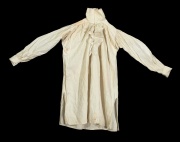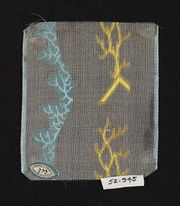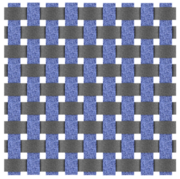Plain weave
Description
One of three fundamental fabric weaving patterns: plain, satin, and twill. Plain weave fabrics are made by passing filling threads over then under each warp thread. The adjacent filling thread reverses the lacing pattern by going under then over each of the warp threads. Both the filling and warp threads are equal in thickness. This weave is very stable when being handled because of the frequent intersections of weft and warp making it dense and less likely to fray at the ends. Plain weave fabrics can be tightly or loosely woven. It is commonly used for linens and other simple cloth formats. Examples of plain weave fabrics are: Calico, Cambric, Canvas, Cheesecloth, Chiffon, Chintz, Crepe, Georgette, Gingham, Homespun, Linen, Muslin, Percale, Organdy, Seersucker, Tabby and Taffeta. Some variations of plain weave fabrics use different size filling and warp threads. Examples of these are Broadcloth, Grosgrain, Poplin, Faille, and Bengaline. Basketweave is a variation in which either the weft or warp or both consists of two of more threads in bundles.
Synonyms and Related Terms
tabby weave; simple weave; linen weave; taffeta weave; ligamento de tafetán (Esp.)
Resources and Citations
- M. Joseph, Introductory Textile Science, Holt Reinhold & Winston, Fort Worth, 1986.
- Hoechst Celanese Corporation, Dictionary of Fiber & Textile Technology (older version called Man-made Fiber and Textile Dictionary, 1965), Hoechst Celanese Corporation, Charlotte NC, 1990
- Rosalie Rosso King, Textile Identification, Conservation, and Preservation, Noyes Publications, Park Ridge, NJ, 1985
- Fairchild's Dictionary of Textiles, Phyllis G.Tortora, Robert S. Merkel (eds.), Fairchild Publications, New York City, 7th edition, 1996
- Edward Reich, Carlton J. Siegler, Consumer Goods: How to Know and Use Them, American Book Company, New York City, 1937
- Wikipedia: plain weave Accessed March 2025



